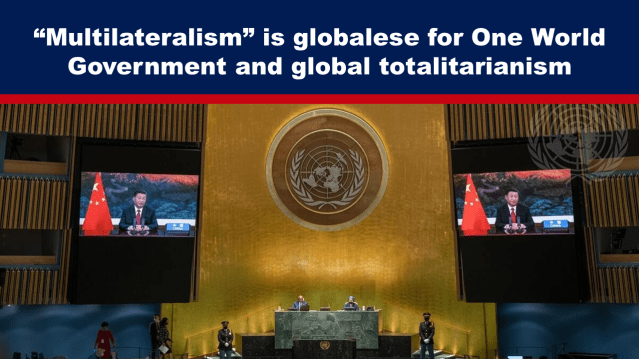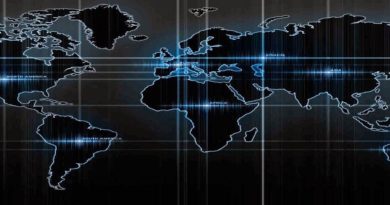“Multilateralism” is globalese for One World Government and global totalitarianism
The UN adopted a Pact for the Future on 22 September 2024, which includes a Global Digital Compact and a Declaration on Future Generations.
The Pact aims to accelerate the completion of the UN’s Sustainable Development Goals and Agenda 2030 and transform global governance. The top priority is total control of the world’s financial transactions and systems, as outlined in the World Economic Forum’s guidebook, ‘The Great Reset’.
The UN proposes an Emergency Platform in the event of a global shock, which could make the Secretary-General a “global emergency czar,” stripping nations of decision-making authority.
The UN’s Common Digital Future promotes shared access and use of digital technology, and seeks to address misinformation, disinformation and hate speech online. The goal is to control information sources and manage public access to information, making it easier to control a well-informed public.
Let’s not lose touch…Your Government and Big Tech are actively trying to censor the information reported by The Exposé to serve their own needs. Subscribe now to make sure you receive the latest uncensored news in your inbox…
Global Tyranny Never Sounded So Good: UN Summit of the Future
By Michael Bryant as published by Health Freedom Defense Fund on 18 October 2024
Lost in the hoopla of the coming US presidential election and the pandemonium of current global affairs was an unheralded summit last month that could cause more upheaval on the planet than anything our self-described world leaders have thrown at the populace yet.
On September 22, representatives of 193 sovereign nation-states gathered at the United Nations headquarters in New York City to adopt a Pact for the Future.
The document, which includes a Global Digital Compact and a Declaration on Future Generations, promises to “open the door to new opportunities and untapped possibilities,” according to UN Secretary-General António Guterres.
The landmark agreement, which Guterres called a “step-change towards more effective, inclusive, networked multilateralism,” contains 56 “actions” that countries pledged to achieve.
The net effect of the Pact for the Future and its two so-called annexes is intended to radically accelerate the push toward completion of the UN’s Sustainable Development Goals (“SDGs”) and its Agenda 2030.
Marketed as a blueprint to “lay the foundations for a sustainable, just, and peaceful global order – for all peoples and nations” (and who could possibly object to such a heavenly vision?) – this latest flurry of UN paperwork may have set new records in linguistic manoeuvres and platitudes per page.
A few questions are in order:
- What do all the bureaucratic bromides and buzzwords in the Pact actually mean when translated into plain English?
- How will the Pact’s sound and fury impact us once its “multilateral” wheels are set in motion?
- Is this “sustainable, just and peaceful global order” really a pot of gold awaiting us at the end of the United Nations Summit of the Future rainbow?
- Are these promises of “new opportunities and untapped possibilities” truly wonderful gifts designed to serve the public? Or are they just more Trojan horses that will carry us closer to the cliff’s edge than into a Canaan-like Promised Land flowing with milk and honey?
- And what exactly did Secretary-General Guterres mean when he said the UN Summit of the Future represented “an essential first step towards making global institutions more legitimate, effective and fit for the world of today and tomorrow” and that UN member states had gathered to “bring multilateralism back from the brink”?
Wading through the finished product, 66 pages of hackneyed phrases passed off as profound policy, requires the stoicism of a saint and a devil’s dictionary in order to translate its conniving “globalese” into a comprehensible tongue.
Rather than answer the above questions one by one, we can turn to the accompanying four-page ‘Concept Notes for the Interactive Dialogues’, which offer a concise version of the Pact’s mind-numbing pages and pages.
The Concept Notes begin by highlighting the need to “transform global governance and turbocharge the implementation of the 2030 agenda for sustainable development.” These notes give us a clear idea of what the priorities were for the two-day “Summit of the Future” as well as the direction that UN 2.0 is attempting to steer the planet.
For instance, the opening line of Interactive Dialogue 1 speaks of “[t]he urgent need for reform of the global financial architecture” in order to “modernise the system while accelerating progress to achieve the Sustainable Development Goals.” Well, those words end our suspense as to what the UN’s top priority shall be: total control of the world’s financial transactions and systems.
The framework for what that new global economic system might look like is articulated in the World Economic Forum’s guidebook ‘The Great Reset’. A deep dive into the details of The Great Reset, made famous by the slogan “You’ll own nothing and be happy,” exposes this pretentious tract as just another long-winded rationale for economic despotism and centralised control over the lives of all the people (read: peons) on the planet.
Next on the globalists’ to-do list is the “urgent” need for a vaguely defined “enhanced multilateralism.”
According to various UN pooh-bahs, the international community is facing challenges that are “too great for any nation, small or large, to tackle alone.” Naturally, the UN proclaims that these undefined “challenges” can be resolved only through mechanisms installed by the UN and its sponsors.
Putting aside the fact that the UN and its affiliates have a track record that proves they are part of the problem instead of the solution to anything, the terms “multilateralism” and “global governance” – repeated throughout the UN documents – need to be exposed for what they actually mean.
Apparently, from what we can ascertain, the UN decided that the more sinister-sounding terms “one world government” and “new world order” had worn out their welcome and were justifiably raising alarm bells in the public square. Thus, kinder, gentler surrogate words have been introduced in an attempt to pacify the people and soften the not-so-fuzzy image of global totalitarianism.
It’s called marketing.
When the curtains are pulled back, exposing the spin machine, we find that the true intent of these autocrats, who claim to “represent the peoples of the world,” is to create a global governance structure with dramatically increased powers over all human activity.
Such a centralised control system would, by design, erode a nation’s ability to control its own domestic and foreign policy, eliminating such “quaint” notions as national sovereignty.
One example of how this might play out in the real world can be found in how the UN pushes the idea that the only possible way to effectively tackle what it determines to be “complex global shocks” is through “multilateralism,” as defined by the UN.
In a March 2023 policy paper titled ‘Strengthening the International Response to Complex Global Shocks – An Emergency Platform’, the UN Secretary-General proposed that “the General Assembly provide the Secretary-General and the United Nations system with a standing authority to convene and operationalise automatically an Emergency Platform in the event of a future complex global shock of sufficient scale, severity and reach.”
In practice, what this could mean is that the standing UN Secretary-General would become a “global emergency czar” who is given the power to preside over any international emergency, be it real or manufactured.
The proposal would strip nations, businesses and the public sector of the right to make their own decisions while handing over all authority to intergovernmental bodies within the UN’s orbit. NGOs, UN agencies and private “stakeholders” would effectively rule, like dictators, over every nation and even over every jurisdiction (province, state, county, city) within each nation. National sovereignty would be null and void.
Another major item on the UN menu is the concept of a “Common Digital Future,” which is embedded within the aforementioned ‘Global Digital Compact’.
Curiously, the UN directly compares these digital technologies to natural resources, observing that the potential of digital technology can be only optimised through shared access and use of resources such as the air around us and the Earth’s bodies of water.
Setting aside the fact that we can’t drink technology or eat data, the irony of the UN suggesting that shared access will be a defining feature of any of its programmes flies in the face of the UN’s history as a vehicle for increased privatisation of the commons.
As part of this “Common Digital Future,” the UN promotes the idea of “working together to promote information integrity, tolerance and respect in the digital space.” Again, more noble-sounding words, but how does the UN propose to do this?
Here’s a clue: The UN offers to help the public sort through the flotsam and jetsam of the social media landscape by promising to “strengthen international cooperation to address the challenge of misinformation and disinformation and hate speech online and mitigate the risks of information manipulation in a manner consistent with international law.”
If you are uncertain as to what that means, consider that the UN is seeking tighter controls over what they judge to be misinformation in order to manage and restrict what information the public can freely access. The end product, if implemented, would allow certain UN agencies to have complete control over all information sources.
This has long been one of the principal desires of the globocrats, who know that a well-informed public that is able to discern between government deceptions (such as the propaganda used to sell the coronavirus crisis) and on-the-ground realities is exceedingly difficult to control.
At the conclusion of the September summit, UN leaders stressed the importance of the need for “a reinvigorated multilateral system.” The countries in attendance reached the consensus that “the world must accelerate progress towards achieving the Sustainable Development Goals.”
If you didn’t hear about the Summit and its outcome on your evening news, don’t be surprised. It was scarcely covered by any nation’s news media. Are your eyebrows raised at the thought of the world’s “leaders” making plans to reshape the earth, its economy, and its inhabitants without so much as a whisper or a whimper from corporate journalists?
If these journalists were to scrutinise the UN’s latest plans, they would find that what is being presented as a new and necessary plan of action is really the same old story of the megalomaniacs’ desire for total control of the planet, dressed up in a shiny new package to conceal their intentions.
The bottom line is that any time you see a programme being forwarded by a gaggle of unelected, unaccountable globalists, you can rest assured that the programme being promised is as thoroughly tyrannical as it can be. And that’s by design.
Featured image: The President of China, Xi Jinping, addresses the general debate of the UN General Assembly’s seventy-sixth session, New York, 21 September 2021. Source: Lowly Institute




